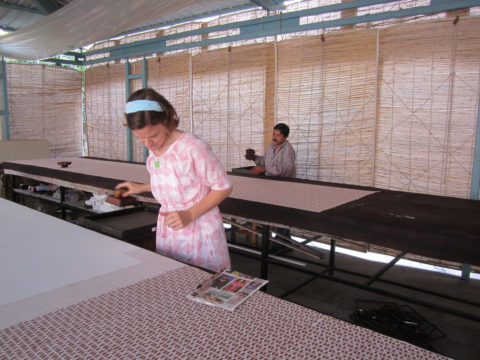
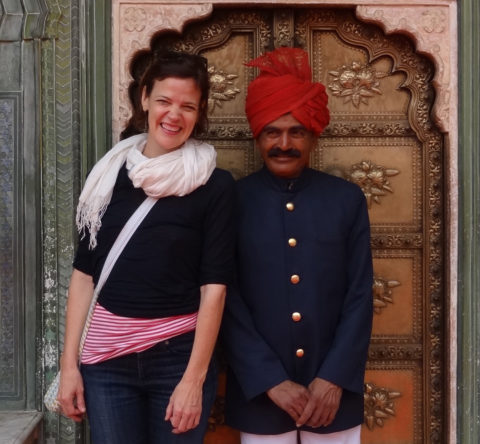
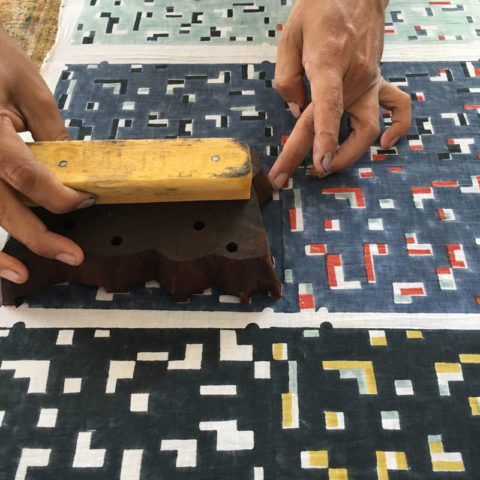
For my very first 52 Weeks of Printmakers post, I’m interviewing Austin-based artist, Rebecca Layton of Rekh & Datta. Trained as a fine artist, Rebecca kept getting distracted by textiles while she was in graduate school, and eventually traveled to India, where she fell in love with traditional Indian block printing.
Rebecca and I will both be doing residencies at Drop Forge & Tool this month, and she will be giving a talk on the history, craft, and culture of Indian block printing on the evening of January 21st. The event is free and open to the public. You can read more about it here.
And now onto our interview!
JH: How did you discover block printing?
RL: During graduate school in art (I went to a very theory- and painting-based program), I kept getting side-tracked into textiles. I was going part-time over 4 years, so I had lots of time to do my own independent study along the way. I studied weaving for several summers and got interested in repeat patterns. I also got interested in the history of wallpaper. I did a summer apprenticeship at a place called the Fabric Workshop in Philadelphia. They have master printers who work with fine artists to develop textiles using screenprinting.
After graduate school, I ended up teaching adults weaving and surface design at a craft school. I had several friends living in India, and on a lark went there with no plan, just to check it out. I fell in love with the traditional block printing and ended up going back to India several years later to live, work, and research for several years. Unlike screenprinting, which tends to be fairly flat, block printing has a great variety of tones. It’s more alive, and you can really see the “hand” in it. In grad school, I had studied printmaking and did do a bit of block printing on paper, but the technique in India is above and beyond anything I’ve seen in the US. I learned how to block print using their technique, but the printers there are such masters, that I ended up collaborating more. I was used to being in the kitchen, so to speak, so it was interesting to step aside and let the masters do the printing. I teach block printing now, but making a yard of fabric vs production printing 100 yards, all hand printed, is another thing entirely. I’m in awe of their craft and precision.
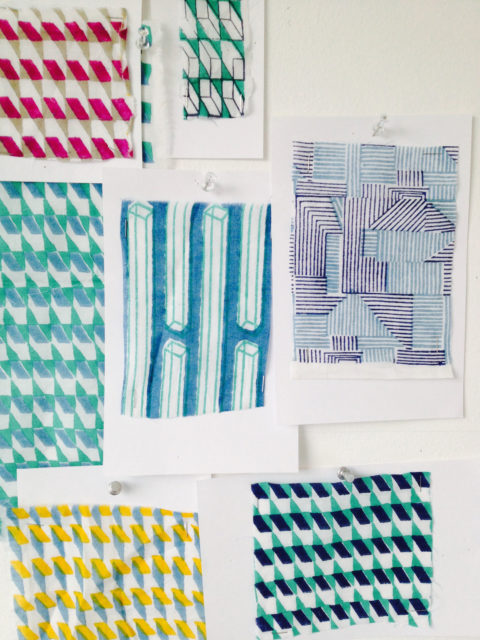
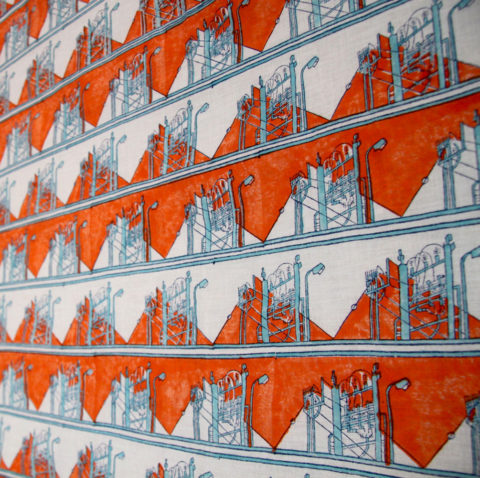
How would you describe your work?
Before moving to India, I was interested in infrastructure. I did a drawn series of buildings, highways, factories, so that was very much on my mind. And the idea of factories kind of crumbling and manufacturing going away here in the US. In India, I was struck by the mashup of several centuries simultaneously — camel drivers on mobile phones, lots of crazy electrical wires, infrastructure in general was a bit more chaotic. And there were these strange concrete buildings going up everywhere. They reminded me very much of Soviet architecture, like tons of these little concrete cells repeated in a massive building. The patterns I came up with were based on a lot of these images. Some were more literal, like repeat patterns of cell phone towers or electrical transformers, some were more abstract and geometric. When I decided to produce clothing with the fabric, I went with the more abstract patterns. But all of my prints have a literal counterpoint in the imagery that they started with.
What’s the first thing you ever remember making?
I think I was 3 or 4 and made a hand print in clay. I do remember pressing my hand in the clay. I still have it. Funny that I ended up getting so into hand printing now! That was the literal start of it.
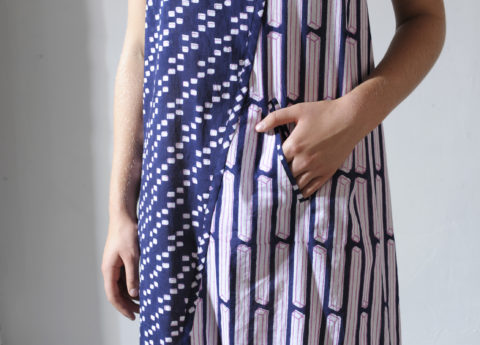
Tell me about your collaboration with the artisans and fashion designer who are also part of Rekh & Datta. How do the limitations (or possibilities) of block printing inform your design process?
When I first learned how to do repeat patterns, it was on a much larger scale. A screen for fabric yardage is about 4’x6’ and so you can design whatever size repeat you want. The wooden blocks used in India can only be about 8” square or thereabouts, so it limits the scale. But that was actually a good limitation for me, as it kept my designs on an intimate scale.
As far as the design process, it worked better when I designed with different combinations of a single block set in mind. If I have about 4 blocks within a single design, that gives me a lot of latitude over time. I could play around with different combinations and colors and get more variety within a relatively simple design. And because I go back to India every year to do sampling, and often play around with the blocks alongside the printer, it feels very collaborative with what we can come up with. I have several designs that came out of this playing around, often with the printer suggesting something I wouldn’t have thought of.
Then, once I have the prints finalized, there is also a lot of back and forth with Monika Jakubiak, the clothing designer I work with. She designs shapes that will work with contrasting prints, so that is built into the process of our creative collaboration.
What are you currently working on, and why?
I love clothing, but it’s really hard to sell, especially online. Fit and style are such big issues with clothes. Monika is taking a break from our collaboration to focus on her own work in London, and so I’m taking this opportunity to do a bit of a re-brand. Keeping the focus on prints, I’m slowly expanding into housewares, linens, bags, and scarves. I’d love to also just sell yardage and see what others come up with on their own.
Do you have a dream project (or two)?
I’d love to some day open my own print shop (if I can find a space big enough). I envision having classes and open studios and creating a community around printing. I’d love to have the space to print on a smaller scale and play on my own. Right now my studio is teeny tiny, and so having lots of space to print yardage would be so great.
Beyond that, I’d love to go to Japan some day. Japanese textiles are unlike any others, over the centuries they’ve developed many techniques that originated elsewhere but became so refined in Japan.
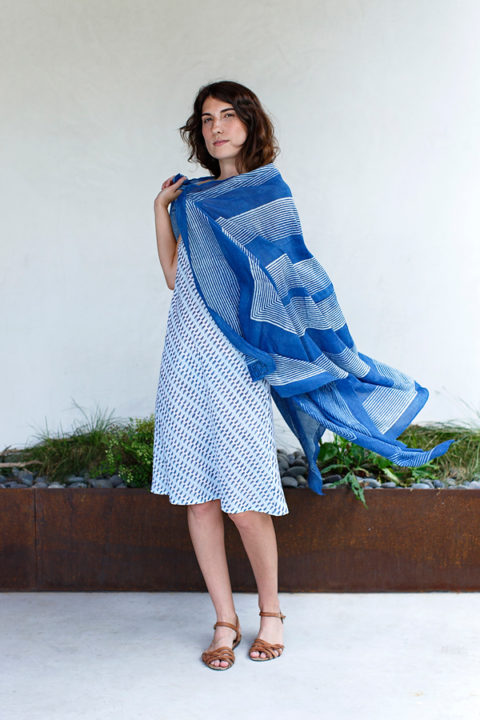
What’s next?
I just bought myself a sewing machine a few months ago, and have started to teach myself to sew. It’s so fun to learn something new, and see my skills improve (slowly).
And of course, I have to do an update on my website. (Don’t we all?) The digital marketing side of things has been the hardest for me, as a solo biz owner. If I could hire more people to help me, that would be such a relief. I envy the younger generation for being able to put themselves out there so easily and gracefully. The introvert in me would like to hide under a rock, at times. But I’m taking it in steps. It’s my spiritual practice.
What advice would you give to someone who is just starting out?
Since I didn’t study textiles in an academic way, and since I’m coming from a fine art background, I prefer to work out designs by hand. I know lots of people work on repeat patterns on the computer these days, but I think there is a lot to learn by doing it the old-fashioned way.
I also think that finding your own voice and look in your work takes many years. An older artist once told me it takes 15 years of making art before you really get your voice. That runs counter to the current immediacy of the world today. But I think it also takes a lot of the pressure off, and after all, you can keep making things until you die. When Matisse was old and couldn’t paint anymore, he cut shapes out with scissors. Agnes Martin was 46 years old when she had her first solo show, and she kept painting until she died at 92. De Kooning’s last decade of paintings were made when he had Alzheimer’s and are arguably his best work. For some reason, I find this comforting!
What do you want readers to know about you or your work?
I love it when people get some meaning out of everyday objects they use. (I assume all of your readers feel the same way!) After living in India, and getting out of the American bubble for a spell, I was struck by how deceptive the retail side of manufacturing is, and how disposable our clothing has become.
In 2014, Monika and I decided to do a community art project called Sewn on the Street. It was part of Fusebox Festival, a hybrid arts festival in Austin, Texas. We set up a pop-up sweatshop under a tent, with sewing machines in our “factory.” We had different country labels on each machine, India, Bangladesh, Mexico, Vietnam, etc. And we encouraged passersby to stop and sew a shirt. We’d then pay them for their time according to the “country” they were sewing in. (We had a box of pennies.) The point was to try to get folks to imagine that there is a person making their clothes, and to think about the true cost of fast fashion. There was a great community of like-minded people in the sewing industry in Austin that volunteered and got involved, and it was a great way to see who was out there locally. We are still in the process of trying to develop sewn manufacturing in Austin, and have a proposal to do just that. (You can read a little write up of the event here.)
How can people find you?
Website: www.rekhdatta.com
